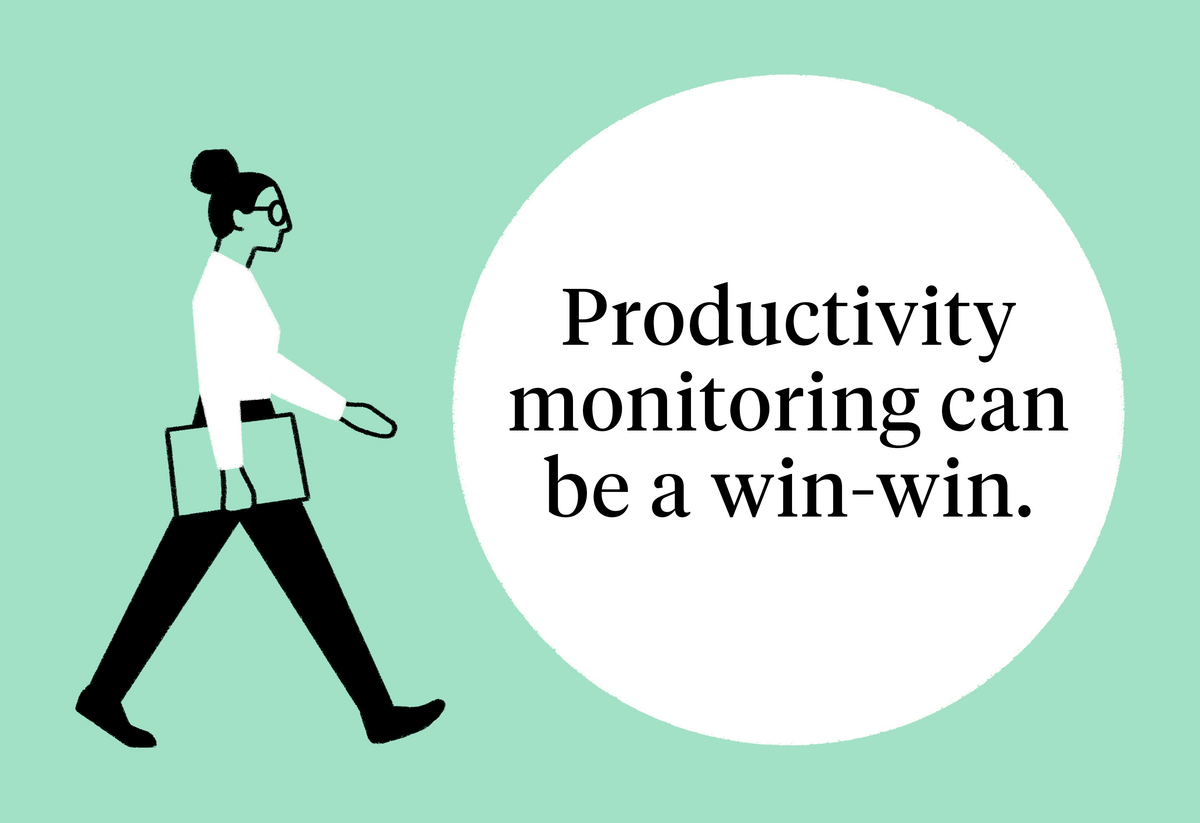Podcast Transcript
Laura PAVIN: In 2022, The New York Times reported that productivity-monitoring softwares are on the rise at workplaces across America. And it did so in a way that left some readers reeling: by tracking their focus as they read the piece.
As you scroll through the article, a little status marker appears on the screen. Green when you’re scrolling; yellow when you stop for even a brief moment. Brightly colored pop-ups appear with messages like “Good job, speedreader” and “Are you there? You’ve been idle for five seconds.” At the end of the piece, you receive a grade.
The piece evoked some strong feelings, if you read the comment section. Many people found it really intrusive, but others pointed out that productivity monitoring can be a helpful way to weed out slackers and even to reward high performers.
Leaders charged with making decisions around implementing this kind of tool might be thinking about the same things. So, can productivity monitoring tools be used to benefit employers and employees? Or is this just the latest example of 21st century micromanaging?
This is The Insightful Leader podcast. I’m your host, Laura Pavin. And today, we’ll be digging into those questions with three Kellogg School professors who have been looking closely at this issue to see what insights they might have.
All three have studied the techniques and impact of productivity monitoring in their research areas, which span from gig workers to knowledge workers to truckers and everywhere in between.
So, let’s dive in.
[MUSIC POST]
PAVIN: Broadly speaking, “productivity monitoring” refers to the practice of tracking employee behavior while at work and encompasses anything from keystroke logging to automatic screenshots to continuous video surveillance.
And though it’s received renewed attention since the COVID-19 pandemic and the rise of remote work, it’s a practice that has been around for decades.
Tom Hubbard is a strategy professor at Kellogg. He’s been studying the use of monitoring tools in the trucking industry since the 1980s.
Tom HUBBARD: The trucking industry’s an interesting place to look because it essentially had monitoring of remote work before most other industries did in the form of onboard computers.
PAVIN: Productivity monitoring in the form of onboard computers and GPS tracking became commonplace in trucking in the late ‘80s and into the ‘90s. It allowed employers to determine whether drivers were preserving the value of their vehicles by observing their behavior on the road. Are they braking too much or too suddenly, for instance?
HUBBARD: But the other thing that they did, especially the more advanced systems, is provide real-time communication, real-time location information, to the dispatcher, which enabled them to coordinate better.
PAVIN: This improved coordination marked a huge development in the trucking industry, according to Hubbard.
HUBBARD: One problem that you have as a dispatcher is finding the individual’s next load and figuring out where they should go next. Well, that’s really hard if you don’t know where they are, right? Because you don’t know when they’re gonna become free. It’s a lot easier if you can see on a screen where all your trucks are to basically find their next role.
PAVIN: For context, truck drivers are paid piece rates, so the less downtime they have, the more they earn. And companies, of course, face a similar challenge, where their revenue is also tied to the amount of goods that they transport. In this instance, monitoring represented a huge win for both parties because it enabled dispatchers to see real-time data on where the drivers were in relation to waiting loads and easily connect them with more-efficient routes. Drivers spent more time on active routes; companies were able to transport more goods—everybody leaves happy.
HUBBARD: So it created a situation where there was a win–win between the employee and the dispatcher or the trucking firm, in terms of adoption.
PAVIN: Hubbard says this win–win outcome is critical to effective productivity monitoring. And it shows that it doesn’t always have to leave employees feeling anxious and dehumanized, contrary to a lot of the public discourse around the topic.
Hatim Rahman is an assistant professor of management and organizations at Kellogg. He’s looked at productivity monitoring through the lens of the gig economy. And he agrees that it’s not all downside for employees. But when it is, he says that usually reflects back on the company using it.
Hatim RAHMAN: And so many organizations choose to make it about incentives—and tying that to performance evaluations and hiring and firing. And I think that reflects organizational values, more so than what’s inherently good or bad about productivity.
PAVIN: So, how can companies implement a productivity-monitoring system effectively? Well, Hubbard says that business leaders who want to get it right need to first ask themselves a question.
HUBBARD: I mean, where you have to start is what do you want people to do? What do you want them to produce?
PAVIN: Hubbard says this question is easiest to answer in the context of piecemeal work that is easily quantified, like working on an assembly line.
HUBBARD: But many jobs are a lot more complicated than that.
PAVIN: Think of a lawyer preparing for trial. Is it more important for them to spend their time polishing their opening statement or preparing their client to take the stand? What about taking a head-clearing afternoon walk? Breaks have been shown to increase productivity after all.
The point is, things get trickier when progress is difficult to define.
Hatim Rahman:
RAHMAN: So, simple rote tasks in which the quality and quantity is easy to measure are more amenable to monitoring, whereas more knowledge-intensive, complex tasks—it’s less clear how to accomplish them and how to measure the quality of those.
PAVIN: Sarit Markovich is a clinical strategy professor at Kellogg who studies the tech and startup world, and she says that not every task lends itself to the kind of progress tracking that productivity-monitoring techniques are generally designed for.
Sarit MARKOVICH: If you think about innovation, then here it’s even unclear what exactly you are looking for. So even defining what you’re looking for is going to be very hard to do.
PAVIN: In this case, a definition might even stand in the way of the kind of creative experimentation and risk-taking that is so crucial to innovative developments.
But let’s say innovation isn’t the top priority. If you’re able to identify a measurable end goal of monitoring, Rahman says the next step is to come back to the win–win.
RAHMAN: In the gig economy, people like to be more on the incentive side. So unlike ride hailing, taxi services, you know, people who are efficient at picking up, being responsive—before monitoring, they weren’t necessarily rewarded for that. But in the ride-hailing context in industries, all of a sudden, those who are more productive and responsive are rewarded in ways that they previously weren’t.
PAVIN: Take Uber for instance. Uber has a rating system for its drivers that takes into account things like how clean the car was, if the driver was careful on the road, even how friendly they were to the rider. Before this type of data was tracked and put to use through an app, drivers who went the extra mile to put a phone charger in the backseat weren’t able to reap any benefit from that. Maybe a bigger tip if they’re lucky. But now they’re attached to a five-star rating that puts them at the front of the line for new fares, highly rated riders, and even promotions.
MARKOVICH: But there are still issues, even when you think about the gig economy, because when you’re thinking about ride hailing, it’s one thing. But if you’re thinking about UpWork, for example, the question is how are you going to be able to identify those that are more productive?
PAVIN: UpWork is a platform that matches freelance knowledge workers with employers who need help with specific tasks like making a spreadsheet, editing a document, or writing a piece of code.
As we learned earlier, tracking performance with more knowledge-intensive tasks like these can be really difficult.
MARKOVICH: And this is where ratings and reviews actually come in, where now those reviews and those ratings are actually very informative and really allow us to be able to identify those that are better performers. And that again provides the right incentives for these better performers to actually show that they are more productive.
PAVIN: So, the keys to good productivity monitoring: having a clear, measurable goal and creating the win–win. Seems simple enough, right?
And yet, it only takes a quick Google search to find example after example of this practice going awry. So what’s going on?
Well, Rahman thinks this is often signaling an issue with trust at the company.
RAHMAN: I was just working on a chapter in a book, and I found this example of how these contract attorneys, um, some organizations are trying to use this monitoring software to see whether they’re engaged or not. But we know with a lot of knowledge-intensive work that, you know, a walk can sometimes help you come up with a breakthrough idea. But if you’re not looking in the proper way, it automatically logs you off. So, I mean, that’s just a really poor job of implementing, explaining, and a lack of trust between employees and organizations.
PAVIN: Markovich agrees, and she points to UpWork as an example. In addition to the ratings system, UpWork makes gig workers record their screens while they work.
MARKOVICH: So whenever they’re doing any kind of work, they need to show you that they actually worked that amount of time and they record their screen. Um, but now we’re getting again into, obviously, privacy concerns. But it’s really about, this idea—it actually really says, “I do not trust you.”
PAVIN: In fact, productivity monitoring has been linked to an increase in worker mistrust. And privacy concerns are a big part of that.
MARKOVICH: I think that the privacy concerns are real, and I think that when someone is really taking either a screenshot of you or just recording what’s on your screen all the time, I don’t think that anyone here can say that they’re never going to look at the news during their day, or look and do something else during the day. And just knowing that someone is really watching what’s on your screen, I think that, in terms of privacy, that’s definitely a concern.
PAVIN: Watching what’s on an employee’s screen can raise serious privacy concerns. Hubbard thinks it goes even beyond that.
HUBBARD: You’re talking about people going onto your screen all the time and looking at you. The problem is that that’s never how they would treat you if you were actually located in the same place, right? That’s why it seems like an invasion of privacy. It’s not really because it’s at your house; it’s because it’s just unusual. That’s not the way that they would…. So it’d be better if they figured out a way of interacting with you that was much closer to the way that they interacted with you and exhibited discretion if you were actually in the same place.
PAVIN: Which begs the question: Does the practice restrict employees in a way that could eventually hurt an organization?
HUBBARD: Well, of course it can.
Tom Hubbard again:
HUBBARD: It goes back to what Sarit said because sometimes what you want isn’t what you can monitor, right? She’s talking about innovation. Well, you know, “define the innovation.” “Well, I don’t know, you know, make it good.” Well, if you define it in that way, then there’s no reassurance that you’re gonna get rewarded for what’s truly an innovation. And so, people will tend to gravitate toward the activities that they know they will be rewarded for rather than the ones that they are not so sure that they’re gonna be rewarded for.
PAVIN: This goes back to the initial question of what do you want productivity monitoring to do?
Because it’s clear that monitoring creates some powerful incentives, even if they’re unanticipated.
As Hubbard just pointed out, through productivity monitoring, companies often end up accidentally disincentivizing good behavior.
Rahman says many of these negative or unintended consequences of productivity monitoring are the result of a flawed design process that doesn’t include employee input.
RAHMAN: Often what I’ve [seen] in the case of UpWork and others is that some of these stakeholders aren’t involved in design and implementation of these monitoring softwares. That’s when I see some misalignment, when it gets wrong. I mean, that’s easier said than done. I know it can be difficult, but I personally would like to see workers, truck drivers, others more involved in how these monitoring systems are designed and implemented. I think that could help generate some of those win–wins in the long term.
PAVIN: Once again, the concept of the win–win seems to be the key here. So how can leaders generate a win–win when it comes to productivity monitoring? Well, including workers in the design process might do the trick. Markovich says transparency can also help here. Give workers a reason to submit to monitoring. Like security.
MARKOVICH: When I know that you are putting any kind of monitoring because safety is a concern, then I’m going to be definitely more willing to do that. What’s happening with Covid, for example? I think that one of the biggest concerns with Covid were actually cybersecurity attacks. So now when you are working remote, then all the VPNs, um, everything is just way more open for cybersecurity concerns. So if you’re putting limitations in terms of what are the websites that you can visit, for example, that are more secure from a cybersecurity concerns perspective? Then now I’m going to be more willing to accept those limitations than otherwise. And many of these websites are going to be websites that if I’m not visiting them, then I’m probably going to also be more productive during the day.
PAVIN: Training opportunities can also be a powerful reason, according to Rahman.
RAHMAN: So if you can use these technologies to help people improve their performance, I think people will be much more willing to accept that type of monitoring if it’s used, again, in their feedback and learning part, rather than tied to sanctions and direct rewards.
PAVIN: And, of course, nothing says win–win like increasing compensation. Here’s Hubbard:
HUBBARD: I think the real win–win is making sure that the productivity gains within the organization are shared within the organization and not just a subset of the organization, right? We’re gonna monitor you more, but we’re gonna pay you more because you’re gonna work harder, okay. And so, therefore, it’s gonna be a win–win because of that.
PAVIN: Really, there are a million ways to create that win–win with monitoring. And every company will need to find the ones that work for them.
But whatever the inroad, Rahman thinks one thing’s for sure: productivity monitoring is probably not going anywhere.
RAHMAN: I hope I’m wrong, but in the short term, I actually see a little bit more monitoring just because of the, you know, like there’s this push towards algorithms and AI. But I hope in the long term it is done more thoughtfully.
PAVIN: So if you find yourself considering—or reconsidering—it for your workplace, just remember Hubbard’s advice.
HUBBARD: Think about what you want; make it a win–win. And if you get those two things right, a lot of the rest of it is gonna be a lot easier.
MARKOVICH: What he said.
CREDITS
PAVIN: This episode of The Insightful Leader was written by Isabel Carter. It was produced by Isabel Carter, Laura Pavin, Jessica Love, Emily Stone, Fred Schmalz, Maja Kos, and Blake Goble. Special thanks to Tom Hubbard, Sarit Markovich, and Hatim Rahman. Want more The Insightful Leader episodes? You can find us on iTunes, Spotify, or our website: insight.kellogg.northwestern.edu. We’ll be back in a couple weeks with another episode of The Insightful Leader podcast.



